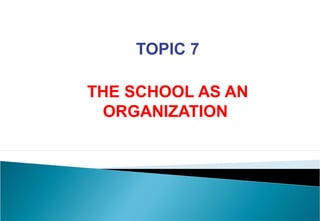More Related Content
Similar to 07 dj t7 (school as organization) dr j) (4)
Similar to 07 dj t7 (school as organization) dr j) (4) (20)
Recently uploaded
Industrial Policy - 1948, 1956, 1973, 1977, 1980, 1991Industrial Policy - 1948, 1956, 1973, 1977, 1980, 1991RKavithamani
07 dj t7 (school as organization) dr j) (4)
- 2. Copyright ©2012 by Pearson Education, Inc. All rights reserved.
1. Components and subsystems of school’s social structure
2.The roles of each subsystems of the school as an organisation;
3. How school goals reflect the concerns of the larger society,
community, participants in the school and individuals;
4. The characteristics of bureaucracy;
5. The problems in using a bureaucratic model in education
settings.
- 3. Copyright ©2012 by Pearson Education, Inc. All rights reserved.
The school is composed of many different subsystems
and parts, such as:
1.The office and staff – to protect the school routine from
unnecessary interruptions
2.Classrooms make up the physical structure of the school,
Key players - teachers and students make up the classrooms.
3.Support services are necessary for the flow of the system –
this may include janitorial, technological, health, and food
services.
- 4. Copyright ©2012 by Pearson Education, Inc. All rights reserved.
the school is a system of social interaction;
it is an organised whole comprised of
interacting personalities bound together in an
organic relationship.
The life of the whole is in all its parts, yet the
whole could not exist without any of its parts
- 5. Copyright ©2012 by Pearson Education, Inc. All rights reserved.
In analysing the school as a social system,
we are actually looking at the planned and
unplanned or formal and informal aspects
of organisational life.
- 6. Copyright ©2012 by Pearson Education, Inc. All rights reserved.
“Schools are far more than mere collections
of individuals;
they develop cultures, traditions, and
restraints that profoundly influence those
who work and study within them”
- 7. Copyright ©2012 by Pearson Education, Inc. All rights reserved.
School & classrooms serve as mediums through which
these goals are achieved
Functions of school :
1.Intellectual – teach cognitive skills
2.Political – develop allegiance to the ruling political
order
3.Social – address social issues & ensure social
cohesion’
4.Economic – prepare students for job market
- 8. Copyright ©2012 by Pearson Education, Inc. All rights reserved.
Stated goals are often different from operational
procedures.
Schools are in charge of putting goals into action.
Two models of organizational control of schools:
1) decentralized schools in which teachers have
workplace autonomy
2) Centralized bureaucracies in which teachers have
little autonomy.
- 9. Copyright ©2012 by Pearson Education, Inc. All rights reserved.
“Goals are the desired ends that guide
organisational behaviour.
Specific goals direct decision making,
influence the formal structure, specify the
tasks, guide the location of resources, and
govern design decisions.”
- 10. Copyright ©2012 by Pearson Education, Inc. All rights reserved.
Views of functionalist & conflict theorists on the
goals’ issues & problems faced by schools
The functional theorists view the act of solving issues
and problems as a way to keep the system in a constant
state of balance.
The conflict theorists believe that problems and issues
reflect inequalities and inconsistencies in the goals and
interests of those who hold power in society and those who
want to see change
(Ballantine and Hammack, 2013).
- 11. Copyright ©2012 by Pearson Education, Inc. All rights reserved.
Bureaucracy is a rational, efficient way of completing
tasks and rewarding individuals based on their
contributions to the work that needs to be done.
Bureaucracy is an important function in our society.
Schools are a bureaucracy, but a unique one, as they are
expected to prepare children for adult status.
- 12. Copyright ©2012 by Pearson Education, Inc. All rights reserved.
1. Division of labor
2. Administrative hierarchy
3. Specific regulations and rules of procedure
4. Formalized and effective neutral role relationships
5. Rationality- formalization, specialization &
centralisation
6. Positions individuals hold in the organization belong
to the organization
- 13. Copyright ©2012 by Pearson Education, Inc. All rights reserved.
1. Huge enrollments
2. Impersonal relationships preclude students from the
advice, mentoring, and counseling they may need
3. Hard to circumvent rules even when it is needed and
rules over-control behavior
4. Teachers and students feel powerless and may
become apathetic
5. Teachers and administrators can develop
bureaucratic personalities
- 14. Copyright ©2012 by Pearson Education, Inc. All rights reserved.
Schools, like all modern organisation illustrate some
characteristics that comply with Max Weber’s model of
bureaucracy;
Loosely coupled organizations - decisions made at
one level are not necessarily reflected at other
levels.
Institutional theory and analysis - concerned with
the influence from the environment and broader cultural
norms on educational systems.
- 15. Copyright ©2012 by Pearson Education, Inc. All rights reserved.
Schools are now considered loosely coupled
organisations : -
ambiguous goals, unclear technologies, fluid
participation, uncoordinated activities, loosely
connected structural elements, and a structure that
has little effect on outcomes. Analyses such as
these are known as loose-coupling theories, and
are useful additions to bureaucratic theory.”
(Weick, 1976; Meyer and Rowan, 1978; Meyer and
Scott, 1983 in Hoy and Miskel, 2001)
- 16. Copyright ©2012 by Pearson Education, Inc. All rights reserved.
How is power and control distributed within school systems?
Two types of decision making - centralized and decentralized:
Centralized decision making would be NCLB and the
standardization of requirements.
Decentralization is site-based management or local control – there
tends to be more academic success in this type of environment
because schools are able to address local needs.
??? Which type do Malaysian schools follow??
